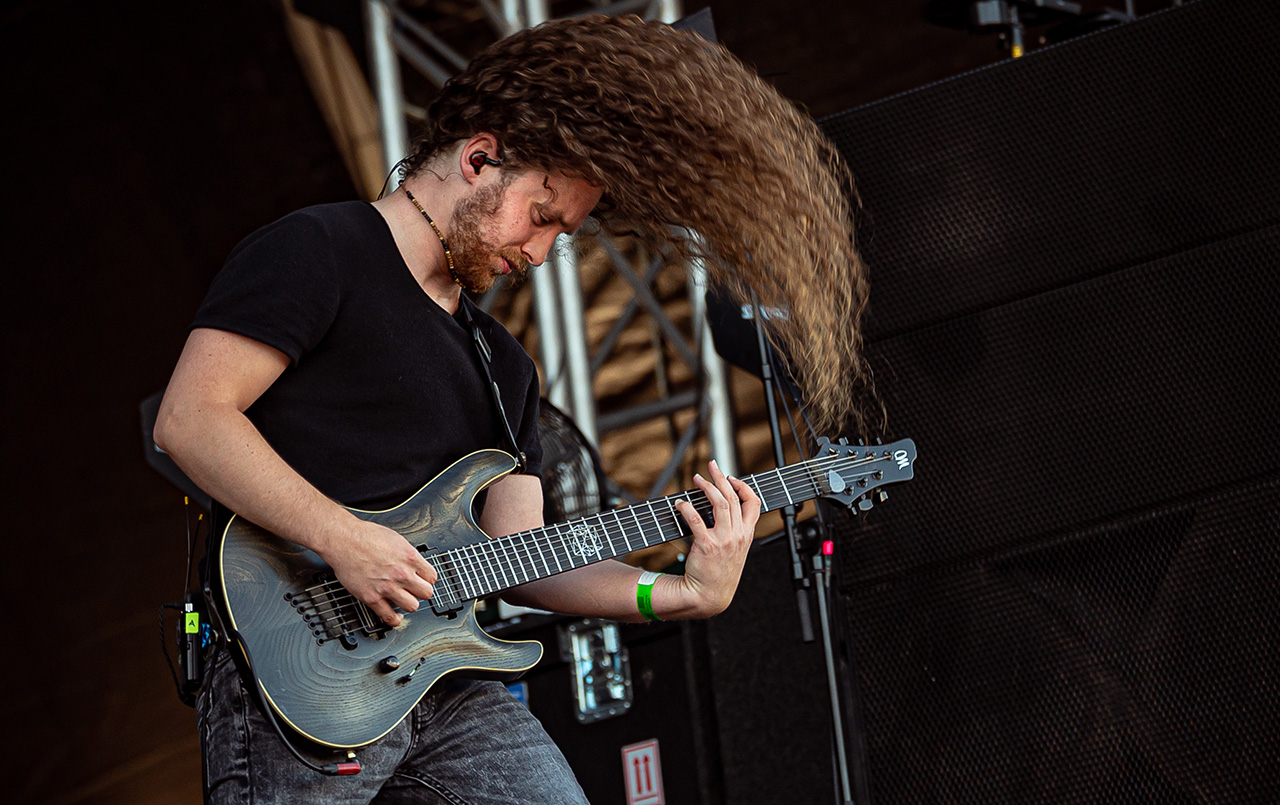
Google ‘djent’ and you’ll be hit with over 2.5 million search results. On Instagram, #djent has been used well over one billion times. So, with players pushing the boundaries of the style of guitar playing for nearly two decades, it’s safe to say that djent isn’t a passing fad.
From its origins with metal titans Meshuggah to its influence on contemporary, world-conquering acts like Sleep Token and beyond, the style’s impact on the guitar has been monumental.
So what exactly is djent? Where did it crawl out from, what makes something ‘djent’, who are its main players and what are the techniques driving one of modern metal’s most influential sub-genres? Here, with the help of some of the genre’s key players, we’ll reveal all.
What is djent?
Djent is an onomatopoeic term first coined by Meshuggah guitarist Fredrik Thordendal as a way to describe his guitar tone. Rumour has it that a few alcoholic beverages had been consumed.
“In particular, it describes the sound of a power chord with an extra fifth stacked on top,” Tesseract guitarist Acle Kahney explains. “The extra fifth is the ‘-nt’ of the djent sound. It’s adding that metallic sound when played with a tight low-end.”
Djent bands can be characterised by their watertight, high-gain guitar tones and often heavily palm-muted, odd time signature riffs which snarl over 4/4 drum beats. This particular approach creates weirdly grooving polymeters that make riffs both angular and accessible.
Where did djent come from?
Djent quickly evolved into a term to categorize the bands who draw heavily upon Meshuggah’s unique sonic template. These bands cut their teeth in online fan forums in the mid-‘00s, where guitarists like Kahney, Misha Mansoor (Periphery) and Paul Ortiz (Chimp Spanner) gushed over the Swedes’ guitar tones, traded tips for emulating those sounds and shared their own djenty jams.
“It was tone-chasing for people who couldn’t afford real amps and nice microphones,” says Kahney.
Mansoor adds: “Guitar nerds love to pursue tones and understand how people do things with commonly available gear. It was this kind of beautiful mystery. Everyone had their own way of trying to get that sound, so it evolved in different ways.”
Production gear was becoming affordable, too. The emergence of Line 6’s quirky kidney-bean shaped POD floor modeller and DAWs for the everyman were game-changers. Suddenly, your bedroom became a studio – which was vital to djent’s budget-stricken development.
Who are the biggest djent bands?
Despite not classing themselves as djent band, Meshuggah are the movement’s undisputed forefathers. Atop Tomas Haake’s relentless drum grooves, the band’s penchant for crunching machinery guitar riffs, disorientating dissonance and Allan Holdsworth-indebted leads has helped inspire a flood of idolizing bands.
Tesseract can be viewed as a purist djent band, with polymetric riffs, glassy clean tones and Daniel Tompkins’ skyscraping clean vocal hooks sticking closely to the stylistic template born from those forums.
Self-identifying as a prog metal band, Periphery’s sonic soup is a little more widescreen. They weave in dizzying fretboard runs alongside jazz, electronic and orchestral elements into their tapestry of dislocated riffs and searing solos.
Djent rhythms are made up of extremes; when a note is played it should be hard and aggressive, but when a note is not being played, there should be no bleeding out
Chimp Spanner’s acrobatic instrumentals, SikTh’s maniacal chaos and After the Burial’s deathcore grunt are all fine examples of early djent.
Monuments, meanwhile, blend metalcore elements into their tight rhythmic attack. Animals as Leaders are the genre’s most successful instrumental band; Tosin Abasi colors their near-algorithmic rhythms with innovative techniques, including thumping and the rainfall-like tonality of selective picking, often via surprisingly low-gain tones.
Honorable mentions also go to The Contortionist, whose 2014 album Language is adored by the djent community; and Car Bomb’s noise-ravaged ‘stuck in a washing machine with a bag of gravel’ aesthetic.
So… is djent a genre?

It’s a discussion that’s raged on since the movement started gaining traction. The debate was immortalized in the title of Periphery’s tongue-in-cheek fifth album, Djent Is Not a Genre – but Mansoor is actually a little more pragmatic.
“Genres are usually named by the fans,” he says. “Like it or not, this style of music is called ‘djent’ and we've retroactively been named a djent band. It doesn’t bother us. If it helps you find us and other bands, then it’s doing its job.”
What are djent guitar techniques?
A strong picking hand is paramount – huge emphasis is placed on both rhythmic accuracy and tightness of sound. As Mansoor says: “You’re going to be obsessing over stamina, how you hold your pick, and how you extract the most out of your palm muting.”
While stamina will naturally come over time – it’s good to practice fast, intricate picking patterns like Meshuggah’s Bleed to build up muscle memory and hone your skills – palm-muting is equally as important.
Djent rhythms are made up of extremes; when a note is played it should be hard and aggressive, but when a note is not being played, there should be no bleeding out. Think of it like a strobe light; it is either on or off, never somewhere in between.
A lot of this is trial and error. Try adjusting how you hold your pick, the angle at which you hit the strings and where on your instrument your hand rests. Periphery’s Jake Bowen notes: “A big part of it is understanding how your playing interacts with these inanimate objects.
“I spent a lot of time with very specific pickups and string gauges to learn how it feels in my hands. Connecting with your instrument is what’s gonna push your playing over the edge.”
Focus on creating silence with as little elements as possible in a high-gain context, like noise gates
Mark Holcomb
However, the value of the left hand should also not be overlooked. Mansoor calls it “an underrated aspect,” explaining: “It helps you get the rhythm out of a lot of those tight parts. You don’t want it be too robotic – it’s like you're playing drums on guitar, and the left hand can almost be your ghost notes.”
“If you’re low on the learning curve,” Periphery’s Mark Holcomb adds, “focus on creating silence with as little elements as possible in a high-gain context, like noise gates. Once you can perfect that, the rest comes very naturally.”
In terms of solos, there are no hard-and-fast rules except: serve the song. Tesseract prioritize texture, while Periphery aim to recreate that scene from Raiders of the Lost Ark with theirs. The choice is yours.
Polymeters
Polymeters are when two instruments play different time signatures at the same time. The drums typically hold down a 4/4 beat, while the guitars play an odd time riff. It keeps the prog element grounded.
Kahney calls them “typewriter riffs.” He says: “You have the pattern, and then, ding! Like a typewriter, it goes back to the start.” But he emphasises that players shouldn’t overthink them.

Speaking to Total Guitar in early 2024, Kahney said players wanting to master djent should “throw traditional looping out the window, learn a phrase or pattern and learn to feel it.”
The rule of thumb is that the guitars will play in a certain set of subdivisions and loop for four or eight bars, creating a nice tidy full measure. The last loop of guitars will either cut short or extend to fit nicely into the 4/4 loop.
You’re altering the tone of the pickup before it hits the amp; getting rid of all that sludge. If it sounds too thin you can always crank the bass up on the amp
Acle Kahney
To number-crunch: there are 32 eighth notes in four bars of 4/4. Therefore a guitar riff in 7/8 can repeat four times, leaving a spare four eighth notes to ‘finish off’ a riff and sync back up with the drums after 32 notes.
For an easy listening exercise, check out the intro to Tesseract’s Lament and try to count or feel where the phrase loops. It’s just a little shorter than a full bar of 4/4, with a very clear slide down marking its end.
Once you recognize that loop, listen to how there’s a push-and-pull with the drum beat beneath it. The drums will remain solid, while the beat on which the one-count of loop lands will change. The push-and-pull effect is quintessential to the djent groove.
Which guitars djent best?
Of course, it’s a matter of preference – but extended range guitars are a common weapon of choice. This is because players can benefit from a lower note range without compromising the high end, which is needed for solos and atmospherics.
When starting out, Mansoor had to order a custom seven string from “a luthier that didn’t think I was insane,” while Bowen sourced his from a “really faraway musical swap meet.” Thankfully, djent has helped popularize these instruments, hugely increasing their availability and affordability.
That being said, many djent bands still play six string guitars. Periphery’s Marigold and Scarlet are in Drop C. A number of songs like Prayer Position and The Bad Thing also employ an A G C F A D tuning, which is essentially a seven string tuning down a whole step, with the sixth string missing.
Lowness isn’t everything, though. The main riff of Bleed is a D#, half a step down from a standard sixth string. With the tightness of the attack so important, it’s essential to play a guitar that’s comfortable. You can make anything djent with the right attitude.
How do you get a djent guitar tone?

There are two key tone types in djent: rhythms and cleans. In both instances, amp modelers have proven to be far better suited than tube amps.
With clean tones, a key trick is removing the cab sim on an amp modeller. Acle Kahney first did it by accident with his POD XT, and ended up loving its “thinner, more piano-y” tonality. The sound became known as the Milton Keynes Clean, in honor of his UK hometown.
To build a clean tone like this from scratch, Kahney recommends a Fender or Roland JC120-style clean amp, minus the cab sim. Then, control the compression and EQ to cut out some of the pick attack. Reverbs and delays can be added as per your preference and help give the tone sparkle and depth.
Rhythm tones
With rhythm tones, it’s all about high-gains without damaging tightness. Luckily, you don’t need a crazy budget to achieve this. Says Kahney: “Even with a cheap EQ pedal, if you crank the volume and cut the lows, you’ll get a fairly tight, Meshuggah-y sound.
“You’re altering the tone of the pickup before it hits the amp – getting rid of all that sludge. If it sounds too thin, you can always crank the bass up on the amp.”
It’s important not to suffocate your tone, though. Periphery’s live rig involves settings of varying tightness which allow the tone to breathe and bloom where it’s needed, only squeezing it when necessary. This can sometimes kick in mid-riff and comes via different EQ variations of the same rhythm tone.
Guitar tricks
Setting up your guitar the right way can help find that Holy Grail of tightness. Tesseract use humbuckers with split coils and are constantly jumping between different positions during songs. Experiment with your guitar to find what works best for you.
“I’ll use the neck pickup on split coil a lot,” Kahney explains. “It can give you a much twangier sound. Then I’ll EQ some of the harshness of the single coil sound out.”
You don’t have to break the bank to sculpt the perfect tone
String gauges and scale length also play their part, too. Longer scale-length or baritone guitars allow for thinner strings without sacrificing tuning stability, which again emphasizes the twang of the instrument.
The empowering thing about djent is that it was born from musicians trying to achieve tight, high-gain sounds on budget equipment – and succeeding. That means you don’t have to break the bank to sculpt the perfect tone. So grab whatever you have to hand, and get creative...







